大学英语精读预备级第三版第一单元课件
- 格式:ppt
- 大小:2.54 MB
- 文档页数:23
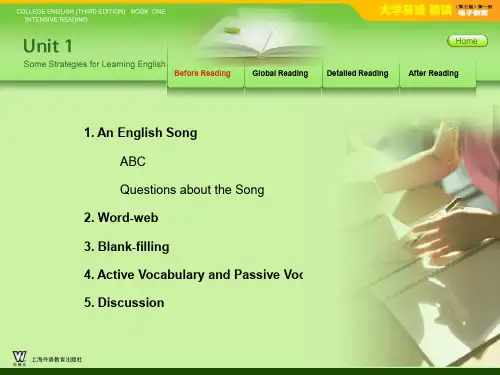
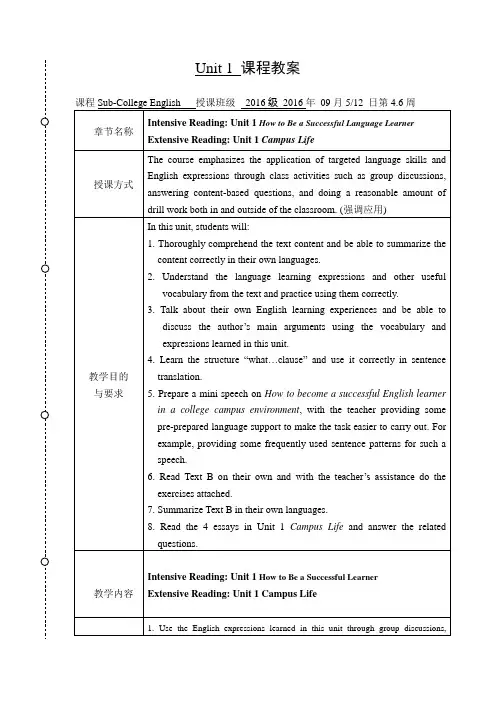
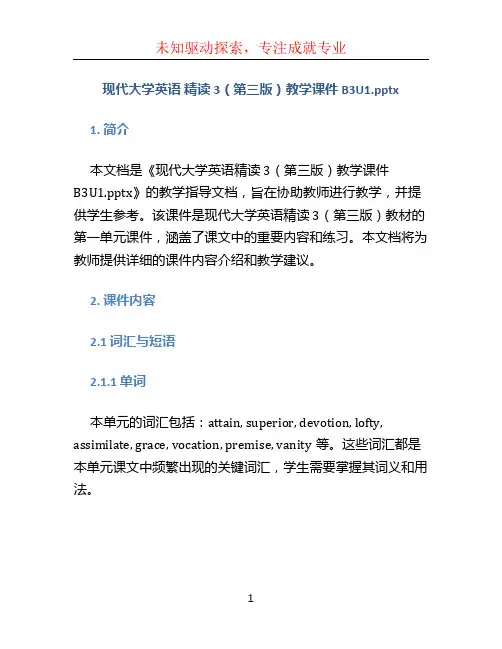
现代大学英语精读3(第三版)教学课件B3U1.pptx1. 简介本文档是《现代大学英语精读3(第三版)教学课件B3U1.pptx》的教学指导文档,旨在协助教师进行教学,并提供学生参考。
该课件是现代大学英语精读3(第三版)教材的第一单元课件,涵盖了课文中的重要内容和练习。
本文档将为教师提供详细的课件内容介绍和教学建议。
2. 课件内容2.1 词汇与短语2.1.1 单词本单元的词汇包括:attain, superior, devotion, lofty, assimilate, grace, vocation, premise, vanity等。
这些词汇都是本单元课文中频繁出现的关键词汇,学生需要掌握其词义和用法。
2.1.2 短语本单元的短语包括:be indicative of, bring out, take…seriously, measure up to, in good part等。
教师可以通过例句和实例来帮助学生理解这些短语的含义和用法。
2.2 阅读理解本单元的阅读理解部分涵盖了三篇文章,分别是《选择正确的途径》、《智慧的力量》和《忠诚的战士》。
教师可以通过课件中的题目和文字说明帮助学生理解文章内容,并进行讨论和解答相关问题。
2.3 语法与写作本单元的语法重点是介词和非谓语动词的用法。
教师可以利用课件中的例句和练习来讲解和巩固学生对这些语法知识的掌握。
此外,课件还包括写作部分,教师可以引导学生根据所学的语法知识写作相关的练习作文。
3. 教学建议3.1 教学方法教师可以采用多种教学方法来教授本单元内容,如讲解法、示范法和讨论法等。
在讲解词汇和短语时,可以先通过示范法来引导学生正确使用,然后进行讨论和实践。
在阅读理解部分,可以采用讨论法来引导学生分析文章内容,并提出自己的见解和观点。
在语法与写作部分,可以通过讲解法和实践法相结合,引导学生掌握语法知识,并培养写作能力。
3.2 学生活动教师应鼓励学生积极参与课堂活动,并提供一些学生活动的建议,如词汇卡片制作和交流、小组讨论、写作练习等。
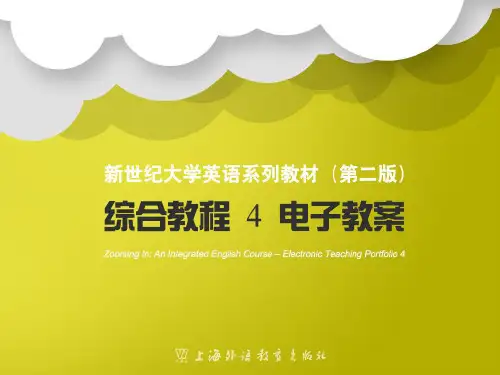
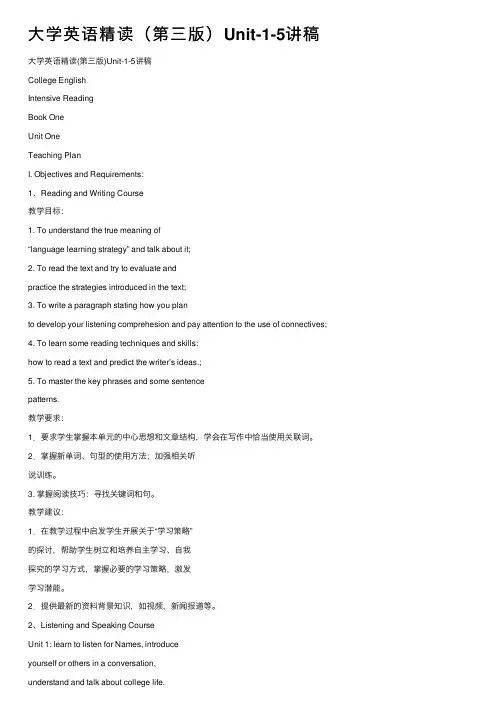
⼤学英语精读(第三版)Unit-1-5讲稿⼤学英语精读(第三版)Unit-1-5讲稿College EnglishIntensive ReadingBook OneUnit OneTeaching PlanI. Objectives and Requirements:1、Reading and Writing Course教学⽬标:1. To understand the true meaning of“language learning strategy” and talk about it;2. To read the text and try to evaluate andpractice the strategies introduced in the text;3. To write a paragraph stating how you planto develop your listening comprehesion and pay attention to the use of connectives;4. To learn some reading techniques and skills:how to read a text and predict the writer’s ideas.;5. To master the key phrases and some sentencepatterns.教学要求:1.要求学⽣掌握本单元的中⼼思想和⽂章结构,学会在写作中恰当使⽤关联词。
2.掌握新单词、句型的使⽤⽅法;加强相关听说训练。
3. 掌握阅读技巧:寻找关键词和句。
教学建议:1.在教学过程中启发学⽣开展关于“学习策略”的探讨,帮助学⽣树⽴和培养⾃主学习、⾃我探究的学习⽅式,掌握必要的学习策略,激发学习潜能。
2.提供最新的资料背景知识,如视频,新闻报道等。
2、Listening and Speaking CourseUnit 1: learn to listen for Names, introduceyourself or others in a conversation,understand and talk about college life.3、C omprehensive Exercises BookUnit 1: The students finish the exercises in their spare time.II. Teaching arrangement & Time Allotment1)Reading and Writing Course 6 periods2)Listening and Speaking Course 2 periods (every two weeks)III. Teaching MethodsCommunicative ApproachLearner-centered TeachingTask-based LearningTranslation MethodMultimedia ApproachIV. Presentation ProceduresLecture notesText: Some Strategies for Learning EnglishPart I. Background Information:1. Today’s English: Worldwide over 1.4 billion people live in countries where English has offical status. One out of five of the world’s population speaks some English. And at present one in five is learning English. With economic globalization and China’s opening up to the world, it has become increasingly important for the younger generation to master English. In a sense, English is not teachable, but learnable.2. Language learning strategies: They are used by learners to complete speaking, reading, vocabulary, listening or writing activities presented in language lessons. Recognizing that there is a task to complete or a problem to solve, language learners will use whatever strategies they possess to attend to the language-learning activity. Possible language learning strategies include: using practice opportunities, self-evaluation, selective attention, time management, reviewing notes taken in class and checking one’s understanding, constantly seeking answers to questions instead of passively receiving information, ect.3. Input-output balance theory in language learning: Input in language learning refers to information read, seen or heard by the learner, while output refers to what the learner produces in writing or speaking. The input-output balance theory in language learning believes that one can learn a language well through maintaining a balance between input and output.Part II. Warm-up Activities:Step 1. Ss Introduce themselves and talk about new college life.Step 2. Topic-centered Discussion(Group work)1.Do you enjoy learning English? Why or why not?2.What do you think is the most effective way of learning English?3.What is the greatest difficulty you have in your learning of English? Step 3. T makes a brief introduction to English learning and learning strategies. Part III. Text Analysis:Main Ideas: (Summary Writing)English as an international language is of vital importance for everybody to learn. Learning English is (绝⾮易事) by no means easy. Besides (持续的刻苦努⼒) sustained hard work, we need employ some learning strategies to (促进我们的学习) facilitate our learning.(我们应当以不同的⽅式对待⽣词) we should deal with new words in different ways. Active words demand constant practice while passive words only need to be recognized. As we try to understand the meaning of a word, we are also reminded of (它们的习惯⽤法) their idiomatic usage.Listening, speaking, reading and writing are the four basic skills that (我们不断努⼒试图获得的) we are constantly trying to acquire. In order to improve the four skills, we are suggested to listen to English every day, (抓住⼀切机会说英语) seize every opportunity to speak, read widely (难度适中的材料) materials at a proper level of difficulty and write regularly. Listening and reading (为我们提供语⾔输⼊) provide us with language input and we are expected to (实际运⽤我们所学的东西)put what we have learned into practice through speaking and writing. Structure:A strategy refers to a set of carefully planned methods for achieving something that is difficult and may take a long time.In introducing some strategies, the author adopts the structure of Problem—Strategy within a paragraph to show us the problems in English learning and then proposes strategies to solve the problems. Please scan the text for some examples of the Problem—Strategy structure.Problems Strategies1. It is impossible to memorize 1. Deal with ative vocabulary and passiveall the new words you are learning. vocabulary differently.2. You don’t know the idiomatic 2. Watch out for not only the meaning of ausage of some words. word but also the way it is used indailylife.3. You may not be able to catch a 3. Listen to it over and over again.lot after listening to a passagefor the first time.4. There are few situations for you 4. Seize every opportunity to speak Englishto practice speaking English at school. with or without a partner.Part IV. Learning points:1). Find out the active expressions:1. by no means not at all2. at fault responsible for something bad that has happened3. watch out for look out for; be on (one's) against4. seek out look for; try to find someone or something, especiallywhen this is difficult5. put…into practice carry out or performTranslate the following into English:1. 我对⽬前的表现⼀点也不满意。

Unit 1 Book 3I. Words and Expressions1. notion: n. an idea, belief or concept*Our management system is based on the notions of personal equality and liberty. 我们的管理体系是基于人的平等、自由观念而建立的。
She has no notion of the difficulty of this problem.CF. idea, concept & notion这些名词均有“思想”、“观点”、观念”之意。
idea最普通,几乎适用于任何方面的思维活动。
concept指从众多实例中通过概括、归纳而形成的对事物本质、全貌及其内部联系的比较系统的概念或看法。
notion指的是一种模糊的、变化莫测的想法,无可靠的基础,是未经深思熟虑的、甚至让人觉得荒谬的观点。
(Directions:) Fill in the blanks with the words above. Change the form where necessary.(1) She seemed unfamiliar with the ______ that everyone should have an equal opportunity. (=concept)(2) I have no _____ how she managed to do this. (= idea/notion)(3) I had a silly _____ that he would come back and beg me for forgiveness. (=notion)(4) Don't get any _____ about revenge. (=ideas)2. criterion: n. standard by which sth. is judged*The company’s criterion for success is high sales.对一些出版商而言,评判一本书是否畅销的标准是长度而非内容。

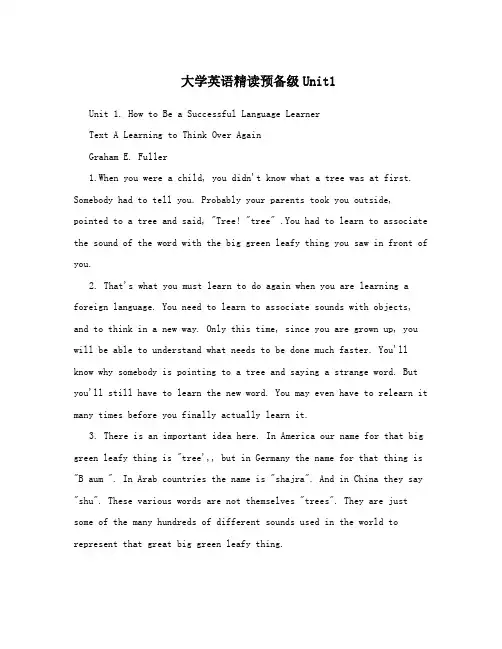
大学英语精读预备级Unit1Unit 1. How to Be a Successful Language LearnerText A Learning to Think Over AgainGraham E. Fuller1.When you were a child, you didn't know what a tree was at first. Somebody had to tell you. Probably your parents took you outside, pointed to a tree and said, "Tree! "tree" .You had to learn to associate the sound of the word with the big green leafy thing you saw in front of you.2. That's what you must learn to do again when you are learning a foreign language. You need to learn to associate sounds with objects, and to think in a new way. Only this time, since you are grown up, you will be able to understand what needs to be done much faster. You'll know why somebody is pointing to a tree and saying a strange word. But you'll still have to learn the new word. You may even have to relearn it many times before you finally actually learn it.3. There is an important idea here. In America our name for that big green leafy thing is "tree',, but in Germany the name for that thing is "B aum ". In Arab countries the name is "shajra". And in China they say "shu". These various words are not themselves "trees". They are just some of the many hundreds of different sounds used in the world to represent that great big green leafy thing.of the total proportion of motorized travel 2014 bus travel at 21.4%, 50% of the total proportion of motorized travel. 1) line survey (1) transit network characteristics, Yibin City status of a total of 30 lines, all for the bus, total length of the line 833.8km4. To learn a foreign language you must get away from the idea of translating words. Translating takes too much time and mental energy. You will never learn to really speak and understand a foreign languageif you have to translate everything. Instead, learn to associate the new sound directly with the image in your mind. So when we hear the sound "Baum" or "shajra" or "shu", we don't want to think, "Hmmmm. Baum means tree, which means that great big green leafy thing."5. Don't think that the challenge of new thinking will be limitedonly to the area of new words; it is going to go much deeper than that. Let's use an analogy: you can build a house using materials of very different sizes and shapes. English uses one set of building blocks, but other languages will usedifferent-shaped building blocks that take some creativity to put together at first. Where we use two blocks, they may use three smaller ones---or maybe one large one.6. Here's an example of an English sentence: We have to buy a few books before going home. When translating into almost any foreign language, you will not take each English word and substitute a foreign word for it. You will instead be substituting groups of words or ideas from one language to the other. How each language will choose to groupthe ideas depends on the language. In French or Spanish, for example, “we have to buy” is broken down into three words: we/have to/buy. In of the total proportion of motorized travel 2014 bus travel at 21.4%, 50% of the total proportion of motorized travel. 1) line survey (1) transit network characteristics, Yibin City status of a total of 30 lines, all for the bus, total length of the line 833.8km Turkish, however, the Turks are able to reduce all these four words to only one.7. So learn to start thinking in terms of bundles of concepts or ideas that will be converted to new language and not single words. Try to think in a foreign language. This isn't all that hard. You learn to think in the language simply by using the language over and over again, asking and answering simple questions until you feel comfortable with the process. Then you add some new words, and a few more new situations, and practice using them together with all the words you learned in previous lessons. Bit by bit you build up skill.8. Once you really get into the language, you'll understand all thisa good deal better. Somebody will be saying something quite fast andyou'll suddenly realize that you understood it all! It's a great moment. Really satisfying. You probably wo uldn’t be able to repeat the words, oreven know how it was that you understood it all. But it's a signthat the language is starting to sink into your mind. You're beginning to understand without translating.of the total proportion of motorized travel 2014 bus travel at 21.4%, 50% of the total proportion of motorized travel. 1) line survey (1) transit network characteristics, Yibin City status of a total of 30 lines, all for the bus, total length of the line 833.8km。

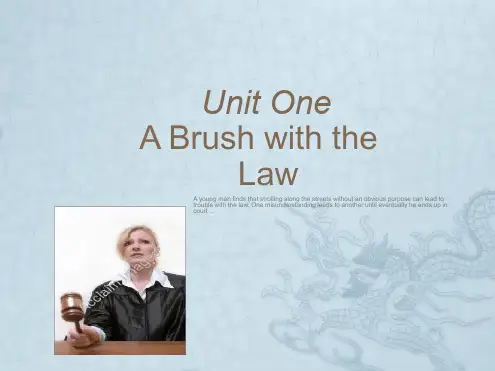
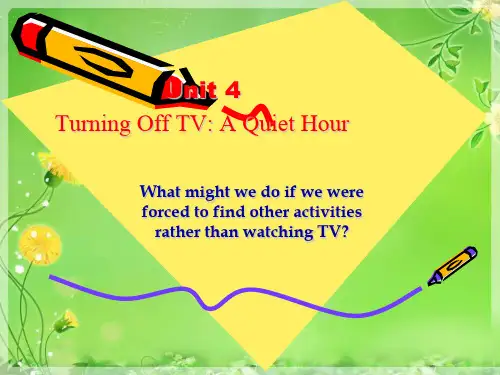
Modern College English (Third Edition) Intensive Reading 1 Tutoring CoursewareI. IntroductionModern College English (Third Edition) Intensive Reading 1 is a courseware designed for college English learners to improve their reading skills. Through intensive reading, students can understand the text deeply, master the language points and grammar, andenhance their reading ability. The courseware consists of four parts: text analysis, language points and grammar, reading skills and exercises.II. Text Analysis1. OverviewThis text is a passage from a novel called "The Little Prince" by French writer Antoine de Saint-Exupery. It is about a little prince who came from a distant asteroid, and he was looking for a friend. The passage tells the story of the littleprince's encounter with a fox.2. StructureThe passage is divided into two parts. The first part is about the little prince's encounter with the fox and the second part is about the fox's advice to the little prince.3. VocabularyThe passage contains a lot of new words and phrases, such as "asteroid", "lonely", "tame", "secret", "wise", "foolishness","friendship", "bond", "essential", "understand", "treasure", "tenderness", "wisdom", "heart".4. Key SentencesThe key sentences in the passage are:"The little prince tamed the fox and they became friends.""It is only with the heart that one can see rightly; what is essential is invisible to the eye.""It is the time you have wasted for your rose that makes your rose so important."III. Language Points and Grammar1. GrammarThe passage contains some grammar points, such as the present perfect tense, the past perfect tense, the passive voice, the modal verbs, the comparative degree and the superlative degree.2. VocabularyThe passage contains some new words and phrases, such as "asteroid", "lonely", "tame", "secret", "wise", "foolishness", "friendship", "bond", "essential", "understand", "treasure", "tenderness", "wisdom", "heart".IV. Reading Skills1. SkimmingSkimming is a reading technique used to quickly identify the main idea of a text. By skimming the passage, we can get an overview of the text and get a generalidea of what it is about.2. ScanningScanning is a reading technique used to quickly find specific information in a text. By scanning the passage, we can quickly find the key words and phrases that are related to the main idea of the text.3. InferenceInference is a reading technique used to make inferences about the text based on the information given. By makinginferences about the text, we can get a better understanding of the text and draw conclusions about the main idea.V. Exercises1. Fill in the blanksThe passage is about a __________ prince who came from a distant __________ and was looking for a __________. The little prince __________ the fox and they became __________. The fox said that it is only with the __________ that one can see rightly; what is __________ is invisible tothe eye.Answer: little, asteroid, friend, tamed, friends, heart, essential2. Multiple choiceWhat is the main idea of the passage?A. The little prince meets a foxB. The fox teaches the little prince a lessonC. The importance of friendshipD. The power of loveAnswer: C. The importance of friendship。